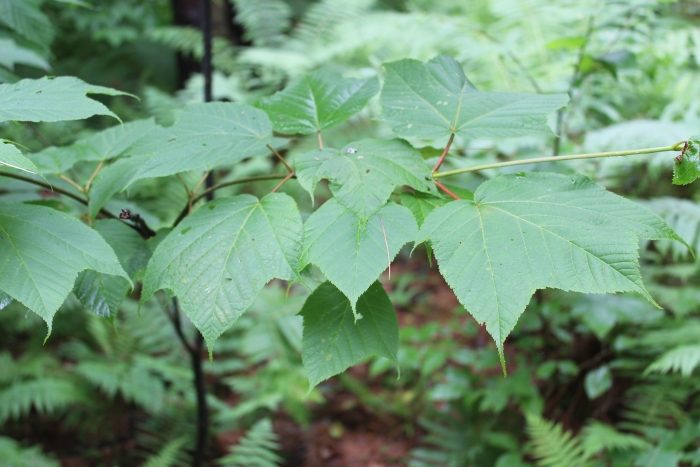Striped Maple
(Acer pensylvanicum)
Striped Maple (Acer pensylvanicum)
/
/

Steven Lamonde
CC BY 4.0
Image By:
Steven Lamonde
Recorded By:
Copyright:
CC BY 4.0
Copyright Notice:
Photo by: Steven Lamonde | License Type: CC BY 4.0 | License URL: http://creativecommons.org/licenses/by/4.0/ | Rights Holder: Steven Lamonde | Publisher: iNaturalist | Date Created: 2021-07-12T14:19:14-07:00 |























































Estimated Native Range
Summary
Acer pensylvanicum, commonly known as Striped Maple, Moosewood, or Goosefoot Maple, is a small deciduous tree native to the understory of deciduous forests in the northeastern United States and southeastern Canada. It typically grows to 5–10 meters (16–33 ft) tall, with a trunk up to 20 cm (8 in) in diameter. The tree’s form is broadly columnar, featuring a short, forked trunk that divides into arching branches, creating an uneven, flat-topped crown. The young bark is distinctively striped with green and white, becoming brown with age. The leaves are broad and resemble a goose’s foot, hence one of its common names. Striped Maple is known for its sequential hermaphroditism, changing sex throughout its lifetime. It blooms in late spring, with inconspicuous yellow-green flowers that are followed by winged samaras.
The Striped Maple is valued for its unique bark and ability to thrive in shaded conditions, making it suitable for woodland gardens and naturalized areas. It is also used as an ornamental tree in residential landscapes for its attractive foliage and bark. This species is particularly noted for its shade tolerance, often germinating and surviving as a small understory shrub before rapidly growing when light becomes available. It requires minimal maintenance and is best suited to part shade environments with low water needs and well-drained soils. While not a canopy tree, it contributes to forest diversity and provides habitat for wildlife.CC BY-SA 4.0
The Striped Maple is valued for its unique bark and ability to thrive in shaded conditions, making it suitable for woodland gardens and naturalized areas. It is also used as an ornamental tree in residential landscapes for its attractive foliage and bark. This species is particularly noted for its shade tolerance, often germinating and surviving as a small understory shrub before rapidly growing when light becomes available. It requires minimal maintenance and is best suited to part shade environments with low water needs and well-drained soils. While not a canopy tree, it contributes to forest diversity and provides habitat for wildlife.CC BY-SA 4.0
Plant Description
- Plant Type: Tree, Shrub
- Height: 15-25 feet
- Width: 12-20 feet
- Growth Rate: Slow
- Flower Color: N/A
- Flowering Season: Spring
- Leaf Retention: Deciduous
Growth Requirements
- Sun: Part Shade
- Water: Low
- Drainage: Fast, Medium
Common Uses
Bee Garden, Bird Garden, Butterfly Garden, Deer Resistant, Drought Tolerant, Low Maintenance, Rabbit Resistant
Natural Habitat
Understory of deciduous forests in the northeastern United States and southeastern Canada
Other Names
Common Names: Moosewood, Moose Maple, Snakebark Maple, Goosefoot Maple, Streifenahorn, Pennsylvanischer Ahorn, Bois Barré, Bois D’Orignal, Érable Bois-Barré, Érable De Pennsylvanie
Scientific Names: , Acer pensylvanicum, Acer striatum, Acer hybridum, Acer canadense, Acer pensylvanicum subsp. typicum, Acer pensylvanicum var. integrifolium, Acer tricuspifolium,
GBIF Accepted Name: Acer pensylvanicum L.